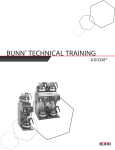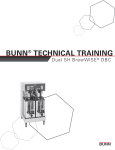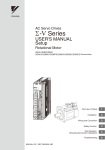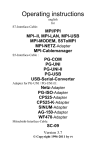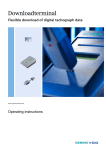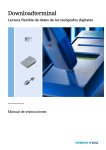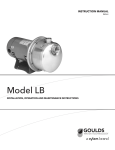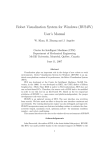Download Bunn Dual TF BrewWISE DBC Troubleshooting guide
Transcript
BUNN® TECHNICAL TRAINING ThermoFresh BrewWISE ® DBC Index Unit 1: Installation Site Requirements............................................................................................................... 4 Location of the Serial Number........................................................................................... 4 Water Supply Install............................................................................................................ 4 Electrical Install................................................................................................................... 5 Initial Start-Up...................................................................................................................... 6 Unit 2: Setup Setup and Programming..................................................................................................... 8 Programming Lockout.................................................................................................. 8 Level 1 Programming.......................................................................................................... 9 Level 2 Programming.......................................................................................................... 9 Level 3 Programming.......................................................................................................... 10 Calibrating Flow Rate.......................................................................................................... 10 Check and Adjust the Dispense Valve Flow Rate...................................................... 10 Check and Adjust the Bypass Valve Flow Rate......................................................... 11 Programming the Recipes.................................................................................................. 11 Calibrating the Temperature Sensing Probe..................................................................... 12 Unit 3: Machine Composition Exterior Overview................................................................................................................ 14 Product Outlets and Removable Parts....................................................................... 14 User Interface................................................................................................................ 14 Accessing the Inside of the Brewer................................................................................... 14 Machine Function and Operations..................................................................................... 15 Main Control Board....................................................................................................... 15 Filling System................................................................................................................ 15 Heating System............................................................................................................. 16 Dispensing System....................................................................................................... 17 Coffee Holding System................................................................................................. 17 Unit 4: Preventive Maintenance Preventive Maintenance...................................................................................................... 19 PM Steps.............................................................................................................................. 19 Unit 5: Troubleshooting Service Tools....................................................................................................................... 22 Test Outputs.................................................................................................................. 22 Test Switches................................................................................................................ 23 Test Frequency.............................................................................................................. 23 Service Fault Messages...................................................................................................... 23 Operator Fault Messages.................................................................................................... 24 Refill, Heating & Brewing Troublshooting......................................................................... 25 Triac Map.............................................................................................................................. 29 Additional Resources.......................................................................................................... 30 Rev. A © 2011 Bunn-O-Matic Corporation. All Rights Reserved Unit 1 Installation Unit Objectives Given a realistic scenario depicting a new site install, the learner will be able to install and setup the brewer for customer turnover without error. Given a new machine, all the necessary tools and safety equipment, the learner will be able to install the brewer without error. The learner will be able to verify that the site requirements have been met. The learner will be able to locate and document the serial number. The learner will be able to hook up the water supply. The learner will be able to hook up the electrical supply. Installation Site Requirements Space • Single TF BrewWISE - Counter able to support the weight of the machine, approximately 120 pounds (water tank full) - Counter area able to support machine placement 35.8”H x 12.5”W x 20.2”D • Dual TF BrewWISE - Counter able to support the weight of the machine, approximately 185 pounds (water tanks full) - Counter area able to support machine placement 35.8”H x 21.8”W x 21.2”D Water Treatment • Sediment filtration to reduce large particles • Taste and odor filter to remove chlorine • Scale filtration as needed • For best results a Bunn Easy Clear® filtration system should be used Plumbing • 3/8” flare fitting on the machine • Dedicated water supply with shut-off • Connected to the cold water supply • Water pressure 20-90psi, set to 50psi if regulator is needed Electrical • Receptacle within 5 feet of machine • If a power cord is not attached to the machine the technician will have to supply and install the cord - Follow National Electric Code set forth by NEC when determining proper breaker, plug and receptacle. • 120/208VAC or 120/240VAC • 3 wire plus ground (Neutral, L1, L2, ground) • 30 amp dedicated circuit (breaker, plug, and receptacle) • Receptacle within 5 feet of machine Location of the Serial Number The machine’s serial number is located on the data plate which is attached to the bottom of the front panel. The complete serial number will need to be documented on all work orders and warranty tags. Water Supply Install Step 1: Check water pressure, install a regulator if above 90psi. Step 2: Flush water lines. Step 3: Install shut-off valve. Step 4: Attach the water line to the 3/8” flare fitting on the bottom of the machine. 4 TF BrewWISE® Training Manual Electrical Install Refer to the electrical section of the machine’s data plate to select the proper power cord, plug and receptacle for the brewer. An electrician must provide electrical service as specified in conformance with all local, state, and federal electrical codes. Step 1: Remove the front panel (11 flat head screws). Step 2: Feed the power cord through the strain relief in the bottom of the machine. Step 3: Attach the wire ends to the terminal block. Step 4: Attach the ground wire to connector on the frame cross bar. Step 5: Check that all connections are tight. Step 6: Tighten the strain relief and replace the front panel. Step 7: Plug the unit into the power source. WHI L2 RED L2 RED WHITE WHITE NEUTRAL L1 BLACK GREEN NEUTRAL L1 BLACK GREEN L2 BLU N RED L1 BLK Note: This electrical service consists of 4 current carrying conductors (Neutral, L1, L2 and L3) and a separate conductor for earth ground. N L3 L2 L1 G GREEN 120/208 and 120/240 volt ac single phase, 60 Hz models Note: This electrical service consists of 3 current carrying conductors (Neutral, L1 and L2) and a separate conductor for earth ground. GREEN 120/208 and 120/240 volt ac 3 phase & multi phase, 60 Hz models SYSTEM VOLTAGE 208 240 V1 208 240 V2 120 120 L1, L2, L3, are the 3 phases V1 = Phase to phase voltage, between any 2 phases. V2 = Phase to neutral voltage, L1 to neutral must be 120V. CAUTION: Do not connect L1 to a circuit operating at more than 150 volts to ground. 5 Bunn-O-Matic Corporation Units without a Neutral The field-switchable Duals will have an internal step-down transformer and a 2-pole contactor in addition to a 3rd heating element. The step-down transformer is a 208/240-120VAC transformer. The transformer is installed for locations that do not have a neutral on site. 200 or 230V L1 BLACK L2 RED GREEN GREEN L3 BLU L3 BLU L2 RED L2 RED L1 BLACK GREEN 200 and 230 volt ac single phase, 60 Hz models L1 BLACK GREEN 120/208 and 120/240 volt ac multi phase, 60 Hz models Note: This electrical service consists of 2 current carrying connect an external neuDo NOT connect an external neutral toDo thisNOT brewer. conductors (L1 and L2) and a tral to this brewer. separate conductor for earthservice consists of 3 current carrying conductors (L1, L2 and L3) and a separate conductor for Note: This electrical ground. earth ground. For single phase installation, (blue) terminalservice is not used. Note:L3This electrical consists of 3 current carrying conductors (L1, L2 and L3) and a separate conductor for earth ground. Initial Start-Up Step 1: Flip the master On/Off switch to the On position. PLEASE WAIT TANK FILLING When the machine is turned on, it will begin to fill the tank. After the tank fills the machine will automatically begin the heating cycle. This will take approximately 20 minutes. Once the water temperature has reached the programmed Brew Lockout temperature it will display the ready screen. The machine will continue to heat until it reaches its programmed shut-off temperature. HEATING WATER TEMP ###° READY TO BREW WATER TEMP 200° 6 TF BrewWISE® Training Manual Unit 2 Setup Unit Objectives Given a realistic scenario depicting a new site install, the learner will be able to install and setup the brewer for customer turnover without error. Given an installed machine, all the necessary tools and safety equipment, the learner will be able to set the machine up for initial operation. The learner will be able to power on the machine. The learner will be able to perform the calibrations. Setup and Programming The BrewWISE® software is the latest evolution of BUNN’s digital brewer control (DBC®) system. The software allows precise brewing control and multiple extraction recipes to be stored on the brewer and onboard troubleshooting capabilities for the technician. The software also allows the brewer to communicate with a DBC® grinder, to reduce operator errors when selecting products and batch sizes. Accessing and using the brewer’s programming features is done from the front panel and requires no special tools. The programming menu is accessed by pressing the hidden switch, located under the trademark symbol, on the right side of the Bunn logo. The hidden switch on the left side will allow you to scroll backwards. Left Hidden Switch Right Hidden Switch ENABLE ENABLE ON / OFF ON / OFF BREW BREW Digital Brewer Control Right Hidden Switch: This is used to access the programming mode and is also used to scroll forward through the function list. Left Hidden Switch: This is used to scroll backwards through the function list. Digital (lower left under the display): This is used to select options that appear on the display during programming. Brewer (center under the display): This is used to select options that appear on the display during programming. Control (lower right under the display): This is used to select options that appear on the display during programming. Programming Lockout While the programming lockout switch is in the On position, the programming menus cannot be accessed. The switch is located on the control board. Remove the top panel, locate the switch and place it into the Enable position. Program Lockout Switch 8 TF BrewWISE® Training Manual Level 1 Programming Press and hold the right hidden switch until the display screen reads “Brew Lockout?” and release. BREW LOCKOUT ? ON DONE OFF This function will lockout an operator if a predetermined temperature has not been achieved message will read “Brew temp to low please wait heating”. Level 2 Programming Press and hold the right hidden switch until the display screen reads “Units” and release. UNITS METRIC DONE ENG This function allows the operator to choose between English or Metric. SET NEW RECIPE ? NO YES This screen is for setting water volumes for the Brew (dump) valve and the Bypass valve. Pulse Brewing will also be found in this screen. REVIEW RECIPES ? NO YES This screen allows the user to preview recipes that are already programmed you can also modify or set the recipes manually in this screen. ASSIGN RECIPE ? NO YES This function allows for assigning a coffee name other than No-Name to the brew switch. COPY SETTINGS ? NO YES If one NO NAME coffee is set up, this function allows you to copy the settings to the opposite side. ENABLE ADS ? NO DONE YES This screen allows the operator to utilize the screen for advertising; a tag card can be programmed with your message. SET TEMP 200O (-) DONE (+) Sets the temperature of the brew tank.. Range of 185°F to 205°F SET READY 195O (-) DONE (+) This function sets the minimum temperature to start a brew cycle (BREW LOCKOUT). Range of 179°F min. to 203°F max. (or within minimum 2° of tank target temp). XXX REFILL 155 (-) DONE (+) Set the sensitivity of the refill circuit. Range of 20 (Open circuit) to 230 (Short circuit). Can be adjusted for different water conditions. Increase number for very soft water. Default is 155 L SPRAY Oz/M: 39.2 (-) DONE (+) R SPRAY Oz/M: 39.2 (-) DONE (+) Enter new number for each sprayhead, after doing CALIBRATE FLOW and measuring output. Enter new number for each sprayhead, after doing CALIBRATE FLOW and measuring output. 9 Bunn-O-Matic Corporation L BYPASS Oz/M: 24.1 (-) DONE (+) Enter new number for each bypass valve, after doing CALIBRATE FLOW and measuring output. R BYPASS Oz/M: 24.1 (-) DONE (+) Enter new number for each bypass valve, after doing CALIBRATE FLOW and measuring output. FLOW CALIBRATE ? NO Technician can measure actual flow rate through all 4 valves with 60 second flow test. YES BREW COUNTERS ? NO YES Allows the operator to track the number of brew cycles completed left, right, Combined (resettable) & Combined (no reset). FUNNEL DETECT ? NO DONE YES YES allows the operator to prevent the start of a brew cycle, must have a Smart funnel. NO does not need Smart funnel to brew. FUNNEL LOCKOUT ? NO DONE YES YES prevents the operator from removing the brew funnel during a brew cycle. SERVICE TOOLS ? NO YES Allows technician 4 test modes, operate all load components, test touch pad switches, and test frequency of funnel sensing coils. FACTORY DEFAULTS NO YES Allows operator to erase anything previously set and returns to factory settings. You will lose calibrations, recipes, adjusted brew volumes, etc. Level 3 Programming Press and hold the right hidden switch for 10 seconds. Insert a digital thermometer probe into the water tank and wait for the temperature reading to stabilize. 200o CAL 200o (-) DONE (+) Check and Adjust the Dispense Valve Flow Rate Step 1: Scroll to Calibrate Flow select Yes. CALIBRATE FLOW ? NO YES Step 2: Select Yes at the next screen to dispense from the brew valves. SPRAY HEAD CAL ? NO YES Step 3: Ensure the sprayhead and funnel are in place and put a container, measuring pitcher or server, underneath the funnel, select Yes. CONTAINER QUIT RDY ? YES 10 TF BrewWISE® Training Manual Step 4: To activate the flow rate check, press the Brew button of the side of the machine you wish to check. Step 5: The valve will open for 60 seconds. Once all of the water has dripped out, input the volume into the brewer. LEFT OZ QUIT 36.0 YES Check and Adjust the Bypass Valve Flow Rate Step 1: Scroll to Calibrate Flow select Yes. CALIBRATE FLOW ? NO YES Step 2: Select No at the next screen to dispense from the brew valves. SPRAY HEAD CAL ? NO YES Step 3: Select Yes at the next screen. BYPASS NO CAL ? YES Step 4: Ensure the sprayhead and funnel are in place and put a container, measuring pitcher or server, underneath the funnel, select Yes. CONTAINER QUIT RDY ? YES Step 5: To activate the flow rate check, press the Brew button of the side of the machine you wish to check. Step 6: The valve will open for 60 seconds. Once all of the water has dripped out, input the volume into the brewer. LEFT QUIT OZ 24.2 YES The process needs to be repeated for both sides of the brewer if applicable. Programming the Recipes with a Recipe Card Every brewer will have a recipe programmed into the main control board. Most often, if a technician is asked to modify a brewer’s recipe it will be done using a recipe card. The recipe card allows new programming data to be uploaded to the brewer wirelessly. The recipe card will contain all of the coffee parameters for the customers coffee flavor profile including: Coffee Name, Brew Volumes, Bypass Percentages, Cycle Times, Initial On Times, and Drip-Out Times. To upload the recipe onto the brewer, remove the funnels and place the card under the left hand funnel sensing coil. The machine will recognize the recipe card and prompt to upload the recipe on the display. TAG CONTAINS RECIPE FOR “COFFEE NAME” SHOW QUIT SAVE TAG CONTAINS RECIPE Instructions for transfer to brewer. • Remove both funnels. • Hold tag under left sense coil. • Display will show “TAG CONTAINS RECIPE” • Follow instructions on screens. NAME:_________________ T oday’s S pec ial 11 Bunn-O-Matic Corporation Calibrating the Temperature Sensing Probe Note: Calibrating the temperature sensing probe (thermistor) should be done when replacing the CBA or thermistor. Allow the tank to heat the water to the ready temperature. No tests should be taken while the tank is heating as the tank temperature must be stable before any readings are recorded. Step 1: Remove the top panel of the machine. Step 2: Gain access to the water in the tank, the thermistor grommet can be removed (keep the thermistor in contact with the water.) Step 3: Place the probe of a digital thermometer into the water and measure the temperature. Step 4: Verify and record the temperature of the water. Step 5: Access level 2 programming by pressing and holding the right hidden switch for 10 200o CAL 200o seconds. The display screen should read “200° Cal 200°”. (-) DONE (+) Step 6: Use the Digital (-) and Control (+) switches to enter the temperature that you recorded from the digital thermometer reading. 12 TF BrewWISE® Training Manual Unit 3 Machine Composition Unit Objectives Given a realistic scenario in which the learner has access to the machine’s internal components the learner will understand the composition and functions of the brewer. Given a realistic scenario requiring the learner to access the internal components of the machine the learner will be able to remove the front panel and top cover. The learner will disconnect the electrical and water supply. The learner will remove the front panel and top cover. Given an operating machine the learner will be able to give a general explanation of how the unit operates. The learner will be able to identify the functions of the main control board and identify the components that correspond to each triac. The learner will be able to identify the components and functions of the filling system. The learner will be able to identify the components and functions of the heating system. The learner will be able to identify the components and functions of the dispensing system. The learner will be able to identify the components and functions of the coffee holding system. 1 Machine Composition 2 4 Exterior Overview 5 Product Outlets and Removable Parts • • • • • • • User interface (1) Display (mounted to the control board) (2) Hot water outlet (3) Funnel sensing coil (4) Funnel (5) Server (6) Data plate (7) 7 6 3 User Interface The user interface is a membrane switch adhered to the front of the brewer. The membrane is connected to the control board by a ribbon cable. The user interface allows the user to select product size and begin a brew cycle. The machine’s display is mounted to the control board. The display is visible on the front of the machine and provides information to the user and to the technician. Batch Selector Switches ENABLE ENABLE ON / OFF ON / OFF BREW BREW On/Off Switch Brew Start Switch Funnel Sensing Coils Accessing the Inside of the Brewer The majority of service work done to the BrewWISE® brewer will require the service technician to access the inside of the unit. The brewer has three removable panels to facilitate access- the front panel, the top panel, and the server base panel. Depending on the repair the technician may have to remove one or all of these panels. In order to work safely the power should be disconnected prior to removal of any body panel. Once the panels are removed the power can be reconnected in order to troubleshoot the machine. The top panel is secured with 4 small flat head screws. To the remove the panel, remove the four screws, lift the front of the panel up and slide the rear backwards to unhook the panel from the brewer’s body. To remove the front panel, first remove the funnels and servers from the machine. The front panel is secured to the brewer with 11 standard screws. Remove the screws and pull the panel straight off of the unit. 14 TF BrewWISE® Training Manual Machine Function and Operations Main Control Board Main Control Board The main control board is the brain of the brewer. In the Digital Brewer Control (DBC®) system, the control board is the single component that contains all of the programming software, it interprets all the data it receives from the level and temperature sensors and activates components to fulfill those demands. The main control board responds to the users input through the membrane switch and activates and controls the brew cycle. The control board can receive data from Smart Funnels® through the sensing coils on the front of the machine. The control board is interchangeable between the single and dual brewers. There is jumper located on the board to select either single or dual with dual being default. In a digital brewer the control board takes the place of the liquid level control board, the timer board, and the mechancal thermostat. All of these components are combined into a single unit. i- Filling System The fill system maintains the level of water in the brewer’s tank. Anytime water is drawn off of the tank during a brew cycle, the fill circuit activates to refill the tank. The fill system consists of: • 120VAC solenoid inlet valve • Fill probe • Overflow cup Water enters the brewer through the water supply line and enters the chassis through copper tubing. The water flows through the inlet solenoid. The inlet solenoid contains a strainer that restricts large particles from passing through. Once water passes through the inlet solenoid, water begins filling the tank. The 120VAC inlet solenoid is activated by the control board anytime the brewer calls for water. The valve opens and allows water to flow, under line pressure, to the top of the tank where the silicon tube connects to an stainless steel fill tube. The fill tube runs to the bottom of the tank where the incoming water enters the tank. The control board monitors the level of water in the tank through a low voltage level probe mounted to the top of the tank. The control board grounds a 2.5VAC signal to the tank through the water. If it loses this signal, the control board will activate the inlet valve. The brewer features an overflow safety system for the fill circuit. There is a tube mounted on the top of the tank that will drain water if the tank fills to the top and continues to fill. The water will drain into the overflow cup; there is a float switch in the cup. When this switch floats to its top position this signals the control board to deactivate the fill circuit and heating circuit. Liquid Level Probe Float Switch Overflow Cup Fill Tube Check Valve (Optional) Inlet Solenoid 15 Bunn-O-Matic Corporation Heating System The heating system consists of: • Water tank • Heating elements • Triacs • Contactor (3 phase only) • High-limit thermostats • Temperature sensor Tank Heater Triac The heating circuit maintains the water in the tank at a preset temperature. This ensures that the water is always ready for brewing. Water for brewing is contained in a stainless steel tank. A Dual BrewWISE tank contains 2 heating elements (3 heating elements if equipped for 3 phase) that are powered by the line voltage into the machine. A single BrewWISE tank will contain 1 heating element. Each heating element is controlled by the control board through triacs. Each heating element circuit has a limit thermostat that will interrupt the circuit if the water in the tank overheats. BrewWISE units without a neutral will have an internal step-down transformer and a 2-pole contactor. The step-down transformer is a 204/240-120VAC transformer. For 3-phase operation, the 2-pole contactor is used in the heating circuit in addition to a triac for controlling the elements. The contactor will control 2 heating elements while the triac will control the 3rd. During heating all 3 elements will be energized. Once the temperature is within 2°F of target, the CPU will open the contactor and the remaining element, controlled by the triac, will heat and maintain the water precisely at the programmed target temperature. If a BrewWISE unit has the capability for 3 phase operation, but is installed to operate in single phase, the center heating element and L3 position of the terminal block will not be used. The control board monitors the water in the tank by a temperature sensor that is in contact with the water. This temperature sensor is a digital thermistor; the control board reads the temperature as value of resistance. The temperature sensor allows the control board to trigger the two heating element triacs when the temperature drops below its programmed value and shut down the trigger voltage when the water temperature reaches the programmed holding value. Tank Heater 3rd Heating Element for 3 Phase goes here. Limit Thermostat Heater Triac Single Tank 16 TF BrewWISE® Training Manual Dual Tank Bypass Valve Dispensing System The dispensing system consists of: • Brew valve • Bypass valve • Sprayhead • Funnel • Funnel lock solenoids Dispense Valve The dispensing system is what makes the brewer a coffee brewer. It dispenses the water onto the ground coffee to create the product. The BrewWISE® brewer is a gravity dump brewing system. During the brew cycle the brew and bypass valves open allowing water to flow from the tank and out the product outlets. The control board opens and closes these valves according to its programming based on the specific recipe called for. The sprayhead, attached to the dispense solenoid, controls the outlet flow rate of the water. The number and size of the holes determines the flow rate. Sprayhead Funnel Lock The brewer has a funnel lock feature; during the brew cycle and the programmed drip out time the funnel lock solenoid will be engaged to prevent the funnel from being removed. It is important to note that the control board supplies 120 DC voltage to the funnel lock solenoid to prevent it from vibrating. Funnel Lock Solenoid Coffee Holding System ThermoFresh® servers are vacuum insulated servers that can keep coffee hot and fresh for hours. The TF server has a removable stand for flexibility and a space saving profile. The built-in drip tray can also be removed for cleaning purposes as well as the sight gauge and faucet assembly. The large cup clearance allows for dispensing into cups, decanters and thermal carafes. Like thermal servers, the TF server must be pre-heated with hot water before it can properly maintain the beverage temperature. 17 Bunn-O-Matic Corporation Unit 4 Preventive Maintenance Unit Objectives Given a realistic scenario depicting a machine requiring a preventive maintenance, the learner will be able to identify which elements of a component need to be serviced without error. Given a machine, all the necessary tools and safety equipment, the learner will be able to identify the components that need to be serviced for the PM. Preventive Maintenance In order to maintain proper operation and long service life BUNN recommends performing the preventive maintenance every 6 months. Individual customers will vary with some customers choosing not to receive preventive maintenance. Tools Required: • 2 Flat blade screwdrivers (#1 - #2) • Phillips screwdriver • 2 adjustable wrenches • Channel lock pliers • Needle nose pliers • Deliming tool BUNN PN: 38227.0000 Prior to servicing the brewer: • Disconnect the electrical supply • Shut off the water supply • Drain the water tank • Remove the front panel • Remove the top panel PM Steps If customer has a BUNN water filtration system installed before the brewer, replace the filter or filter cartridge and purge before installing to the brewer. Step 1: Rebuild the inlet solenoid □□ Shut off the water supply. □□ Remove both wires from the refill valve. □□ Disconnect both water lines at the valve. □□ Remove the two 1/4”-20 screws securing the valve to the component mounting bracket. Step 3: Remove and clean the fill tube □□ Using an adjustable wrench remove the tube fitting from the fill tube on top of the tank □□ Gently pull the fill tube out of the top of the tank □□ Wipe any mineral deposits from the exterior of the tube □□ Clean any mineral deposits from the bottom of the tube □□ Clean any obstructions from the interior of the tube □□ Reinstallation is the opposite of removal Step 4: Rebuild the by-pass solenoids □□ Remove the hose clamps that secure the tubing to the valve □□ Remove the two nuts that hold the solenoid bracket to the machine □□ Gently remove the tubing from the valve body □□ Using a flat blade screwdriver, remove the four screws and separate the valve assembly □□ Replace plunger, spring, and rubber seat using the rebuild kit. □□ Clean any mineral build-up from the valve □□ Reassembly is the opposite of disassembly Step 5: Rebuild the dispense solenoids □□ Disconnect the wire leads to the solenoid □□ Unscrew the sprayhead from the bottom of the valve □□ Remove the securing nut from the bottom of the valve □□ Remove the clip from the tube on the valve fitting □□ Remove the tube from the barbed fitting on the rear of the valve □□ Remove the valve from the brewer □□ Remove the four Phillips head screws and disassemble the valve □□ Replace plunger, spring, and rubber seat using the rebuild kit. BUNN P/N: 11517.0008 19 Bunn-O-Matic Corporation □□ Clean any mineral build-up from the valve □□ Reassembly is the opposite of disassembly Step 6: Clean the tank fittings that supply water to the solenoid valves (Note depending on the age of the brewer this will be either a single “T” connector or individual connectors for the dispense and bypass tubes.) □□ Remove the clip from the end of tubes □□ Gently remove the tubing from the tank fittings □□ Use a screwdriver to remove and mineral build-up from the fittings □□ Reattach the tubing and clips Step 7: Remove and clean the temperature sensor □□ Gently pull the temperature sensor from the grommet in the top of the tank □□ Wipe any mineral build-up from the sensor □□ Reinstallation is the opposite of removal Step 8: Remove and clean the fill probe □□ Gently pull the fill probe out of the grommet □□ Wipe any mineral deposits off of the probe Step 9: Remove and clean the sprayheads □□ Using the pointed end of the deliming tool, remove any mineral build-up from the sprayhead outlet holes Step 10: Replace the seat cups in all the TF server faucets □□ Ensure the server is completely empty □□ Unscrew the faucet bonnet from the assembly □□ Remove the old faucet seat cup □□ Install the new seat cup. □□ Reassembly is the opposite of disassembly Step 11: Replace the seat cup in the hot water faucet □□ Unscrew the faucet bonnet from the assembly □□ Remove the old faucet seat cup □□ Install the new seat cup. □□ Reassembly is the opposite of disassembly Step 12: Check funnels, handle and tip are tight □□ Ensure the screw securing the handle to the funnel is tight □□ Ensure the funnel tip, the bottom outlet, is tight □□ Check funnels for proper operation S MA R T F U N NE L Step 14: Examine water supply for any leaks, reconnect water supply Step 13: Examine power cord for any damage, reconnect power supply Step 15: Check the funnel lock solenoids for proper operation (Note the brewer must be on to perform this step) □□ Manually activate each funnel lock in the Systems Tools menu Step 16: Calibrate flow rates (Note the brewer must be on to perform this step) □□ Follow the procedures in section 2 of this manual Step 17: Check the TF servers for proper operation. □□ Check for Leaks and proper venting through the lid assembly. 20 TF BrewWISE® Training Manual Unit 5 Troubleshooting Unit Objectives Given a realistic scenario depicting a broken machine, the learner will be able to effectively troubleshoot, diagnose, and repair the problem returning the machine to normal operation. Given a machine displaying an error message, all the necessary tools and safety equipment, the learner will be able to access the software and diagnose the problem. The learner will be able to access the programming menu. The learner will be able to navigate to the Service Tools menu. The learner will be able use the Service Tools menu to test inputs or outputs. Given a list of error messages and issues, the learner will be to identify the probable cause of the message or issue. Given a brewer with a defective component, the learner will be able to test the component to determine the cause of the defect. Troubleshooting and Repair Service Tools The BrewWISE® brewer features on-board troubleshooting. Since all of the machine’s components are controlled or activated by the control board, you can activate and test components individually from the user interface. This allows you to listen to solenoid valves opening, observing the flow of water or test to see if a component is receiving voltage using a meter. The Service Tools option is located in Level 1 of the programming. Enter Level 1 programming by pressing and holding the right hidden switch for 3 seconds. Use the right hidden switch to scroll to the “Service Tools” screen. Press the Control button to select “Yes”. This will enter the “Service Tools” feature. SERVICE TOOLS ? NO YES In the “Service Tools” selection their are 3 screens available, by selecting “Yes”, you will enter that test function, by selecting “No” you will move to the next test. TEST OUTPUTS? NO YES Test Outputs supplies voltage to load components in the brewer. TEST SWITCHES? NO YES Tests the inputs from the membrane switch. TEST FREQUENCY? Indicates the transmit frequency of the funnel sensing coils. NO YES Test Outputs LEFT BREW VALVE ON NEXT OFF RIGHT BREW VALVE ON NEXT OFF REFILL VALVE ON NEXT OFF 22 TF BrewWISE® Training Manual LEFT BYPASS ON NEXT OFF RIGHT BYPASS ON NEXT OFF TANK HEATERS ON NEXT OFF LEFT FUNNEL LOCK ON NEXT OFF RIGHT FUNNEL LOCK ON NEXT OFF HEATER CONTACTOR ON NEXT OFF Test Switches TEST SWITCHES? NO NOTHING PRESSED YES Press any of the input buttons on the membrane switch, the display will show which button is being pressed. ENABLE ENABLE ON / OFF ON / OFF BREW BREW Test Frequency TEST FREQUENCY? NO YES SERVER124.7 REMOVED Khz .5 5. 124.7 Khz IN PLACE The funnel sensing circuit is tuned to 125 kHz. If the circuit is not tuned correctly, then the funnel information will not be transferred to the brewer. Therefore, the microprocessor is constantly fine tuning to get as close as possible to 125 kHz. It has eight possible tuning steps numbered 0 - 7. When you look at the “TEST FREQUENCY” screen you see something like (124.7 KHZ .5) The 124.7 is the frequency, and the 5 is the tuning step. The decimal point next to the 5 indicates the funnel is being detected; if the funnel is removed the decimal point should turn off. Service Fault Messages The brewer features several error messages for problems occurring within the machine. These error messages be show up on the display. This indicates that the tank overflow is full. The unit may be overfilling or boiling. This message will appear if the control board does not see the programmed water temperature within 60 minutes. This message will appear if the control board does not see the tank fill within 30 minutes. If the control board lose contact with the temperature sensor or senses shorted connection it will display this message. 23 Bunn-O-Matic Corporation Operator Fault Messages The following fault messages will appear on the display if the operator needs to take corrective action. The brewer does not sense a funnel in place. The brewer will only display this message if Yes has been selected in the Funnel Detect programming menu. Otherwise the unit will brew. Wait for the brewer to heat up to proper temperature. The brewer will only display this message if the Brew Lockout feature is set to NO. The brewer did not see the funnel removed since the previous brew cycle. The brew switch was turned off during the brew cycle. Component Testing and Troubleshooting A troubleshooting guide is provided to suggest probable causes and remedies for the most likely problems encountered. If the problem remains after exhausting the troubleshooting steps, contact the Bunn-O-Matic Technical Service Department: 1-800-286-6345 • • • • • • • Inspection, testing, and repair of electrical equipment should be performed only by qualified service personnel. All electronic components have 120 - 240 volt ac and low voltage dc potential on their terminals. Shorting of terminals or the application of external voltages may result in board failure. Intermittent operation of electronic circuit boards is unlikely. Board failure will normally be permanent. If an intermittent condition is encountered, the cause will likely be a switch contact or a loose connection at a terminal or crimp. Solenoid removal requires interrupting the water supply to the valve. Damage may result if solenoids are energized for more than ten minutes without a supply of water. The use of two wrenches is recommended whenever plumbing fittings are tightened or loosened. This will help avoid twists and kinks in the tubing. Make certain that all plumbing connections are sealed and electrical connections tight and isolated. This brewer is heated at all times. Keep away from combustibles 24 TF BrewWISE® Training Manual Problem Equipment will not operate. Probable CauseRemedy 1. No power or incorrect voltMeasure the voltage at the terminal age. block and confirm that it matches the voltage specified on the brewer data plate within +/- 10%. Brew cycle will not start. 1. No water Check plumbing and shut-off valves “ “ 2. ON/OFF switch Test the ON/OFF switch. Refer to the Test Switches in SERVICE TOOLS section. “ “ 3. Brew switch Test the BREW switch. Refer to the Test Switches in SERVICE TOOLS section “ “ 4. Brew Valve Test the Brew valve. Refer to Test Outputs in SERVICE TOOLS section. “ “ 5. Electronic Control Board Substitute a control board known to be in good working order. Automatic refill will not operate or display shows “FILL TIME TOO LONG”. 1. No water Check plumbing and shut-off valves “ “ 2. Water strainer/flow control (.750 GPM) (A) Direction of flow arrow must be pointing towards direction of water flow. (B) Remove the strainer/flow control and check for obstructions. Clear or replace. “ “ 3. Refill Probe or Sensitivity Setting Check the sensitivity setting. Refer to Refill Threshold section in this manual. “ “ 4. Refill Valve Test the Refill valve. Refer to Testing Individual Components. “ “ 5. Overflow Protection Switch When this condition occurs, the brewer will display OVERFLOW CUP FULL. EMPTY CUP. The reason for overfilling could be a defective refill valve, an incorrect sensitivity setting, (see above) or boiling “ “ 6. Electronic Control Board Substitute a control board known to be in good working order Water flows into tank continuously with power removed from brewer. 1. Refill valve Foreign material lodged in valve, holding it in open state Water flows into tank continuously with power applied to brewer 1. Refill Probe or Sensitivity Setting Check the sensitivity setting. Refer to Refill Threshold section in this manual. “ 2. Electronic Control Board Substitute a control board known to be in good working order. 1. Limit Thermostat Remove power from the brewer. Press reset button on limit thermostat. Then check for continuity through it. “ Water will not heat or display shows HEATING TIME TOO LONG CAUTION - Do not eliminate or bypass limit thermostat. Use only replacement part #23717.0003 25 Bunn-O-Matic Corporation Problem Water will not heat or display shows HEATING TIME TOO LONG, (Cont.) Probable CauseRemedy 2. Tank Heaters Remove power from the brewer. Check for continuity through the tank heaters. “ “ 3. Triac Remove power from the brewer. Connect a voltmeter across one of the tank heaters. Reapply power to the brewer. If the full supply voltage is measured when the tank heater is turned on, and zero voltage is measured with the triac off, then the triac is good. If half the supply voltage is measured, the triac is defective. If very low, or zero voltage is measured, there could be a defective triac or a defective control board. “ “ 4. Electronic Control Board Perform the above procedure for testing triacs. If the voltage measured is very low or zero, then substitute a control board known to be in good working order. Spitting or unusual steaming from sprayhead or air vents. (Water too hot) 1. Triac Remove power from the brewer. Connect a voltmeter across one of the tank heaters. Reapply power to the brewer. If the full supply voltage is measured when the tank heater is turned on, and zero voltage is measured with the triac off, then the triac is good. If half the supply voltage is measured, the triac is defective. If very low, or zero voltage is measured, there could be a defective triac or a defective control board. “ 2. Lime Buildup Inspect the tank assembly for excessive lime deposits. Delime as required. “ CAUTION - Tank and tank components should be delimed regularly depending on local water conditions. Excessive mineral buildup on stainless steel surfaces can initiate corrosive reactions resulting in serious leaks “ “ 3. Electronic control board Perform the previous procedure for testing triacs. If the voltage measured is very low or zero, then substitute a control board known to be in good working order Inconsistent beverage level in server. 1. Strainer/flow control (.750 GPM) (A) Direction of flow arrow must be pointing towards the brewer. (B) Remove the strainer/flow control and check for obstructions. Clear or replace. “ 2. Improper water pressure Check operating water pressure to the brewer. It must be between 20 and 90 psi. “ 26 TF BrewWISE® Training Manual Problem Inconsistent beverage level in server. (Cont.) Probable CauseRemedy 3. Brew Valve Test the Brew Valve. Turn the valve on for 30 seconds and collect the water dispensed from the sprayhead. Repeat the test several times to confirm a consistent volume of dispensed water. If not consistent, check the valve, tubing and sprayhead for lime buildup. “ “ 4. Bypass Valve If bypass is being used on the inconsistent brewing recipe, test the Bypass Valve. Turn the valve on for 30 seconds and collect the water collected from the bypass opening. Repeat the test several times to confirm a consistent volume of dispensed water. If not consistent, check the valve, tubing and bypass opening for lime buildup. “ “ 5. Lime buildup Inspect for lime buildup that could block the tank, tank fittings, tubing, valves and sprayhead. Consistently high or low beverage level in server. 1. Brew Volume adjustment Adjust the brew volume as required to achieve the recommended volume for each brew cycle. Dripping from sprayhead. 1. Brew Valve Repair or replace leaky valve. Water overflows filter. 1. Type of paper filters BUNN paper filters should be used for proper extraction. “ 2. No sprayhead Check sprayhead Beverage overflows server. 1. Beverage left in server from previous brew The brew cycle should be started only with an empty server under the funnel. “ 2. Brew Volume adjustment Adjust the brew volume as required to achieve the recommended volume for each brew cycle. 1. Type of paper filters BUNN paper filters should be used for proper extraction. “ “ Weak beverage. “ “ 2. Coffee A sufficient quantity of fresh drip or regular grind should be used for proper extraction. “ “ 3. Sprayhead The correct B.O.M. sprayhead should be used to properly wet the bed of ground coffee in the funnel. “ “ 4. Funnel Loading The BUNN paper filter should be centered in the funnel and the bed of ground coffee leveled by gentle shaking. 27 Bunn-O-Matic Corporation Problem Weak beverage. (Cont.) “ “ Probable CauseRemedy 5. Water temperature Empty the server, remove its cover, and place the server beneath the sprayhead. Place empty funnel over the server entrance, with ON/ OFF switch in the “ON” position press the start switch and release it. Check the water temperature immediately below the sprayhead with a thermometer. The reading should not be less than 195˚F (91˚C). 6. Incorrect Recipe Consider adjusting bypass percentage, preinfusion, or pulse brew. Contact Bunn-O-Matic for suggestions. Brewer is making unusual noises 1. Plumbing lines Plumbing lines should not be resting on the counter top. “ “ 2. Water Supply (A) The brewer must be connected to a cold water line. (B) Water pressure to the brewer must not be higher than 90 psi. Install a regulator if necessary to lower the working pressure to approximately 50 psi. “ “ 4. Tank Heaters. Remove and clean lime off tank heaters. 28 TF BrewWISE® Training Manual Triac Map 1 2 3 4 5 6 7 8 9 10 1. Left Funnel Lock 2. Right Funnel Lock 3. Left Transformer 4. Left Dispense Valve 5. Right Dispense Valve 6. Left Bypass Valve 7. Right Bypass Valve 8. Right Transformer 9. Spare 10. Refill Solenoid 29 Bunn-O-Matic Corporation Additional Resources Visit the BUNN Online Learning Center for technical information on BUNN equipment. Unit Objectives • • • • • Go to URL: http://training.bunnserve.com/ Go to the menu bar and place your cursor over Courses, then choose “Commercial”. Browse the list of available courses. From the course introduction, use the menu on the left to find instruction sheets, manuals, key learnings, checklists and updates on equipment. BUNN also has a wide range of instructional videos posted on the Online learning center and iTunes. You may subscribe to these videos via email, RSS, or as a podcast. After subscribing, you will be notified when a new video is posted. QR Code Reader For quick and direct access to technical resources on the BUNN Online Learning Center, you can download a QRReader application for your SmartPhone . • • • • Download QRReader Application for your SmartPhone. Open the QRReader application on your SmartPhone. Aim your SmartPhone Camera as if you are taking a picture of the QR code image. (image on the right) The QRReader Application will direct you to the BOLC, where you will have access to many resources relating to BUNN beverage equipment. Technical Service & Support Contact Information • TF BrewWISE Course Technical Service Department can be reached at: 1-800-286-6345 (Operators are available from 6:30 am to 5:30 pm CT. Monday - Friday) Calls received after hours or weekends will go through our Telemessaging Service. You will then be connected to the first available service representative. Email: [email protected] ©Bunn-O-Matic Corporation, 2011. All rights reserved. Bunn-O-Matic Corporation - 1400 Stevenson Drive - Springfield, IL 62703 - Ph: (800) 637-8606 - Fax (217) 529-2177































